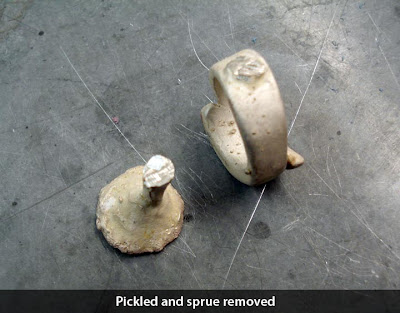Soft Wax & Sheet Wax
We were introduced to soft wax and sheet wax. Extremely pliable. Use of an alcohol lamp to heat up the tools allows you to add or take away wax to your sculpture, as well as connect pieces of wax together. There is also soft wax wire that can be twisted or heated up on the ends to create drops or balls on your sculpture.
Carving Wax
Carving wax is what we used to create our first ring sculptures. There are 3 types: hard (green), medium (purple) and soft (blue). The soft wax is better for fine detail. Using a twisted metal saw blade, we cut blanks from a wax ring tube. Using a gauge and divider, the blank is measured and scribed to mark where your middle and carving spots will be. It's like making a map for your sculpture.
Finishing
Any textures you have on the wax will appear in the metal. So sanding and smoothing are important if you want a clean look. The best thing to use to smooth is old pantyhose or nylons. They burnish the wax and you are able to see spots that might need more sanding.
Sprue & Weight
A sprue is a channel for the metal to flow into the wax sculpture. It's created out of wax and attached to the sculpture at an angle to reduce air bubbles. Once the sprue is attached to your sculpture, you need to weigh your wax to figure out how much metal you need. Luckily, the calculation is fairly simple. Weight of wax in grams x 11 (specific gravity of silver) x 1.2 (an extra 20%) = The amount of silver in grams that you need.
Investment
Attach your sprue to the base of the flask with brown wax. Make a tootsie roll shape and stuff brown wax into base hole. Create a hole for the sprue in brown wax, then build up with wax and melt together. Next coat all of the wax with a debubble-izer solution and let it dry completely for about a half hour.
Mix investment plaster: sift slowly as powder dissolves itself and pour into flask when thick. You have 9 minutes TOTAL to mix and pour. Put flask on vibrating wheel and tap the sides to eliminate air bubbles. Let this set for 10 minutes, then scrape off the excess plaster on top. Remove the bottom slowly and store in a plastic bag.
Casting
When ready to cast, put your flask in an oven or kiln to melt out the wax. A mold is left by your investment. Casting is done using a centrifugal or spin casting method. The spin caster is wound up and held in place with a pin. Then pre-heat the crucible so it is ready for the metal. Pour your silver metal into the crucible and heat up until the metal is molten. The flask is placed in the cradle and with the bottom facing the crucible so the metal will flow into the flask. Re-heat your metal until molten again. Drop the pin that is holding the device still, then let go, remove heat and allow it to spin and cool until it stops.
Remove your flask and allow it to cool for about 10 minutes. Then quench it in water to remove the investment. Find your metal and clean off the excess investment.
Clean up and Polishing
Put your metal in a pickle pot to clean off the dark oxidation. Then remove your sprue by sawing and begin the sanding and polishing clean up of your piece!











No comments:
Post a Comment